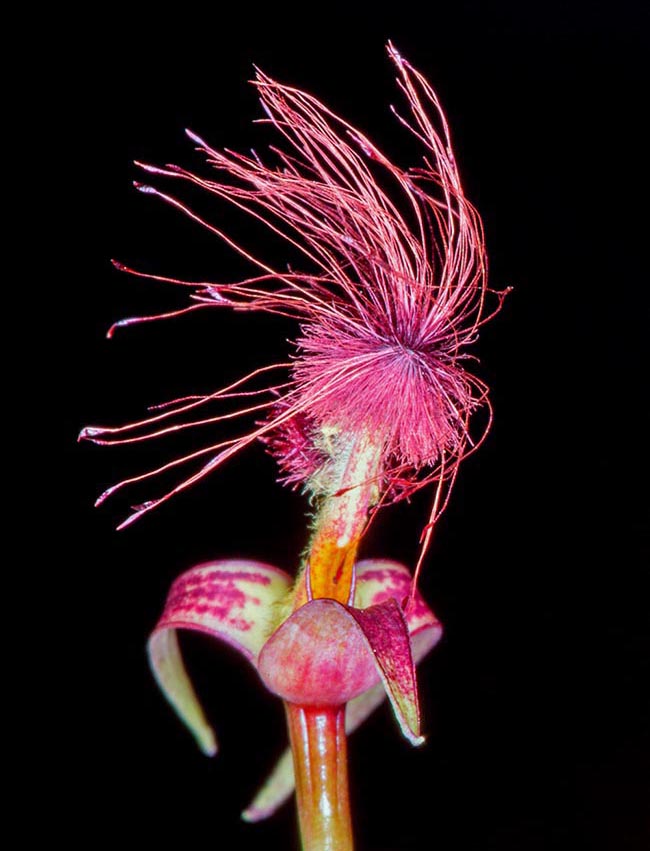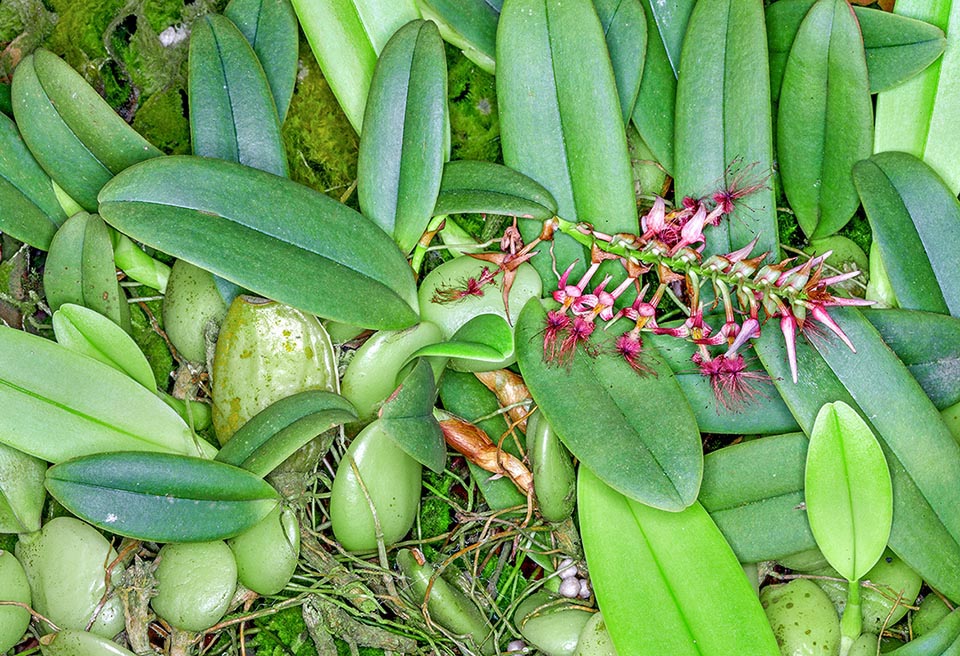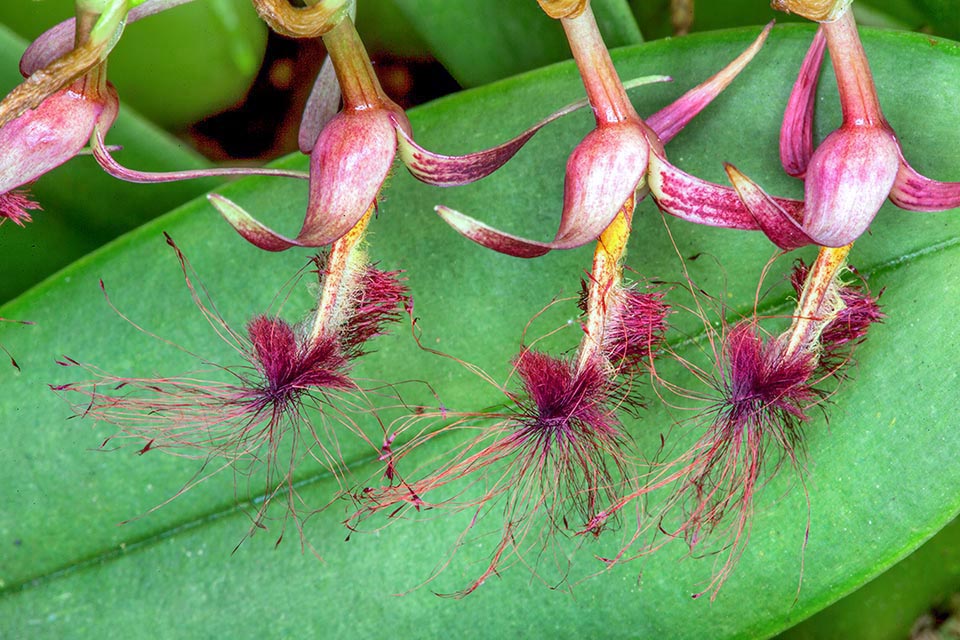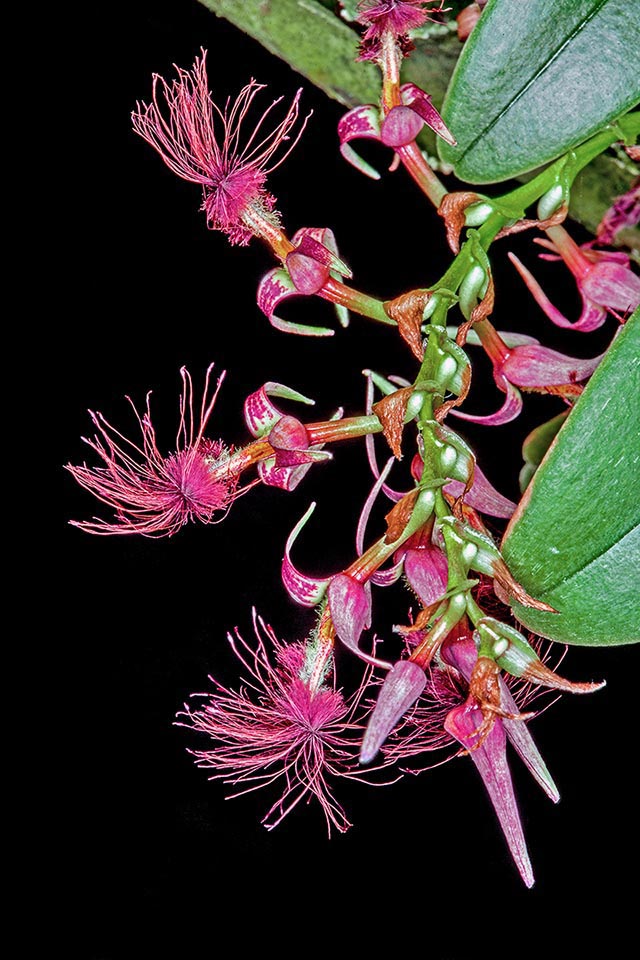Family : Orchidaceae

Text © Prof. Pietro Pavone

English translation by Mario Beltramini

Of African origin, Bulbophyllum barbigerum is an endangered orchid with odd flower © Giuseppe Mazza
Bulbophyllum barbigerum Lindl. (1837) is a species of the subtribe Dendrobiinae, tribe Malaxideae, subfamily Epidendroideae, family Orchidaceae.
It is found in Ivory Coast, Sierra Leone, Guinea, Liberia, Nigeria, Gabon, Cameroon, Central African Republic, Congo and Zaire on trunks covered by moss and on the crowns of trees in evergreen and deciduous primary forests from 900 to 2300 m of altitude.
This species was described by John Lindley (1799-1865) observing a specimen coming from the Sierra Leone, that bloomed in 1836, in the gigantic steam-heated greenhouse, situated in Hackney (London), owned by the brothers Loddiges, William (1776-1849) and George (1786-1846), growers of many botanical rarities.
Lindley published the name of this species in the illustrated magazine Edwards’s Botanical Register Vol: 23, Londn (1837) and in the description of the distinctive characteristics added: “it’s a very curious plant with such a strange conformation that the same drawing that depicts it is completely unable to represent it correctly”.
The name of the genus comes from the Greek “βόλβος” (bolbόs) meaning ‘bulb’ and. “φύλλον” (phyllon), ‘leaf’, with reference to the pseudobulbs on which the leaves grow.
The specific epithet comes from the Latin “barbatus”, bearded, because of the tuft of hairs present on the labellum of the flower.
This species, currently called Bearded bulbophyllum, is protected against the trade because it is in danger of extinction in the wild and as such inserted in the appendix II of Washington Convention (CITES) that has the purpose of protecting the endangered flora and fauna prohibiting their export and detention.
Thanks to a substantial funding provided by the Federal Ministry of Agriculture, Forestry, Environment and of the Management of Water Resources with function of CITES Management authority for Austria, the Botanical Garden of the University of Vienna (HBV), that has, in its greenhouses, a rich collection of Bulbophyllum, has realized three different lists of all endangered species of this genus (Bulbophyllum-Check-list).

Small, 10-20 cm tall, epiphyte, has lenticular pseudobulbs, grouped on the rhizome, with only one up to 13 cm long leaf. The 7-18 cm loose inflorescence has 12-32 flowers © Giuseppe Mazza
The first list contains all the names of the known species, in alphabetical order, the second all the names validly accepted (they too in alphabetical order), the third presents the distribution. of the various species depending on their origin country. The purpose was to give non-botanists a valid tool for the correct information concerning the species that are to be protected.
Bulbophyllum barbigerum is a small epiphyte, 10-2O cm tall, with 1,5-3,5 lenticular pseudobulbs, of olive green colour grouped on the rhizome. Each pseudobulb bears only one leaf on a short petiole. The lamina is up to 13 cm long, 1,7-3 cm broad, strictly elliptical and oblong-ovate, coriaceous and thick.

The 2,5 cm long flowers emit a rotten meat odour, because they are pollinated by flies attracted by the tuft of reddish hairs of the lip, mobile at the first breeze © G. Mazza
From the base of the pseudobulb takes form a loose inflorescence, with unthickened rachis, 7-18 cm long that carries 12-32 flowers. The flowers, with 6-10 mm long bracts, measure 2,5 x 1,5 cm, are glabrous, with yellow external tepals, often with red-violet spots internally, and rudimental (0,8 mm and to 0,35 mm) inner greenish tepals.
The column (gynostemium) is erect, glabrous, up to 15 mm long. The pollinia are 4, in 2 pairs, waxy. The lip is mobile because it is loosely attached at the extremity of the foot of the column. It is 8-11 mm long, 1-1,5 mm broad, of yellow greenish colour, with red-violet spots, covered by short white hairs at the base and by long and dense reddish hairs at the apex, very delicate.

Due to this continuous winking, like an eye blink emphasized by the movement of the lip, in the past they hypothesized that this species maybe was the missing ring between flora and fauna © Giuseppe Mazza
At the slightest breeze, these flowers move to attract better the attention of pollinators.
Due to this movement of theirs, an ancient belief, baseless today, hypothesized that these plants might be the missing ring between plants and animals.
Blooming takes place in spring and lasts about thirty days.
The flowers emit an odour of rotten meat being pollinated by flies. During their blooming, the plants of Bulbophyllum barbigerum are elegant and singular.
They are easy to cultivate and may grow in pot as well as bare root inside an orchidarium as they require a tropical climate with summer temperatures of +27-28 °C during the day and +20-21 °C the night, winter of +25 °C the day and +17-18 °C the night.
The humidity must maintain high (75-85%) and the luminosity medium, even if these plants may tolerate conditions of low light conditions.
The blooming has a 12-13 h photoperiod.
To obtain the best growing results, in winter, it is good to maintain the loam a little drier between waterings but never completely dry for more than three days.
The best substratum is the New Zealand sphagnum moss. For the plants cultivated in the baskets, it is good to water them frequently and from all sides.
It is recommended to use a slow-release mineral for orchids and occasionally apply a spray fertilization on the roots after having wet them.
As they have short roots, the baskets or the pots, if not too deep, are more functional for their growth.
Synonyms: Phyllorchis barbigera (Lindl.) Kuntze (1891).
